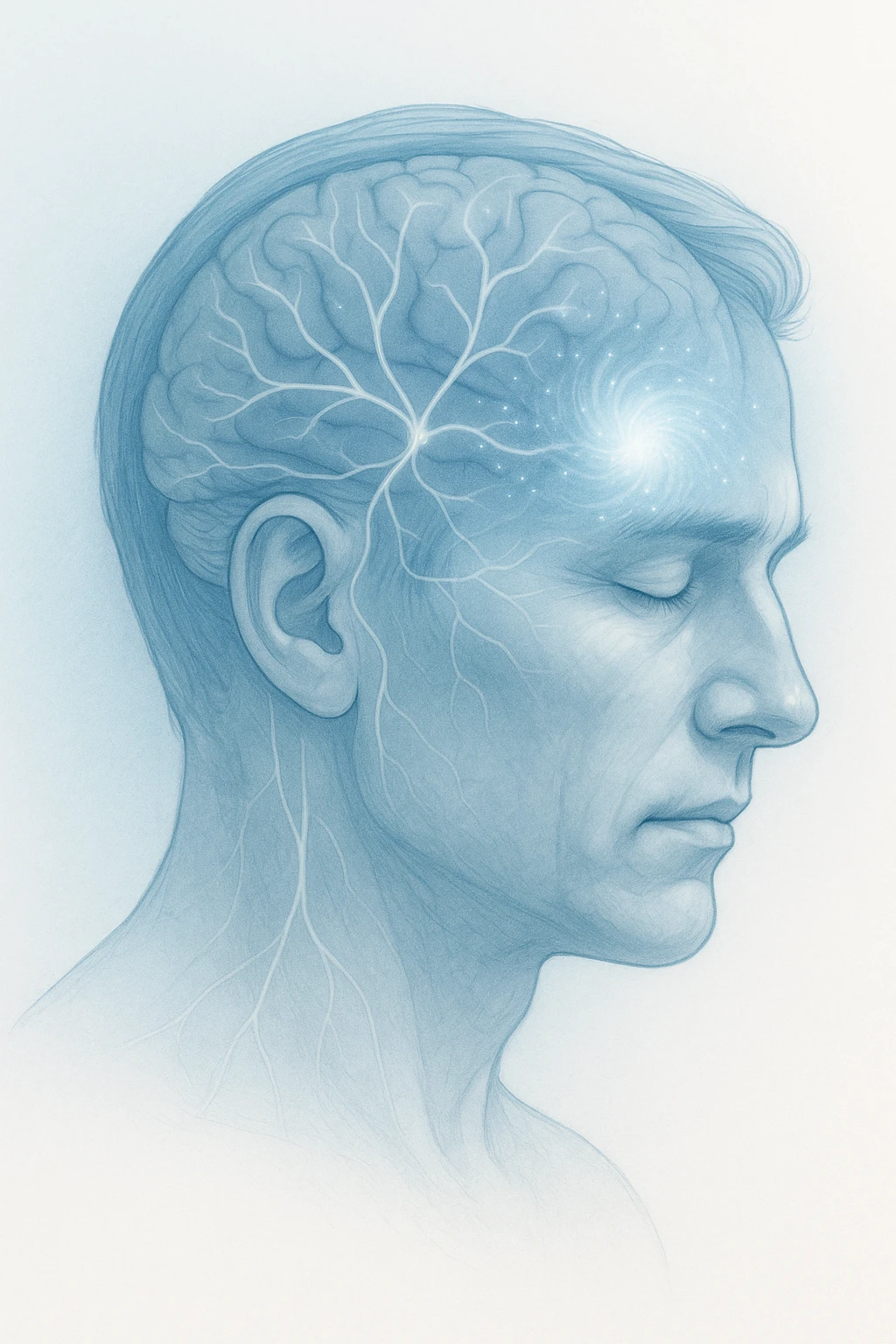Migraine Aura Types and How They Differ
What Migraine Aura Is and How It Fits Into a Migraine Attack
Migraine aura is a set of temporary neurological symptoms that can appear before or during a migraine headache. These symptoms happen because the brain’s normal signaling is briefly altered, which affects how a person sees, feels, or communicates in the moments leading up to the headache phase. Unlike the pain of the migraine itself, an aura is focused on changes in the nervous system and how the brain processes sensory information.
Not everyone who has migraines experiences aura, but for those who do, it can serve as an early warning sign of a migraine attack. People often learn to recognize these early changes, which can help them understand what is happening and prepare for the next stage of the migraine.
How Aura Fits Into the Migraine Stages
An aura typically occurs just before the headache phase of a migraine, acting as a transition from feeling well into the onset of pain and other symptoms.
- Can overlap with the headache in some cases
- Represents a temporary, reversible change in brain function
- Helps distinguish migraine aura from other neurological conditions
Most aura symptoms last less than an hour before fading on their own. They come and go as part of a defined migraine phase, distinguishing aura from conditions that cause lasting or progressive neurological changes. Because aura is brief and resolves completely, it is recognized as a key feature that helps clinicians identify migraine patterns based on how attacks unfold over time.
What Aura Symptoms Look and Feel Like
Migraine aura can affect how a person sees, feels, or communicates for a short period of time. These symptoms reflect temporary changes in how the brain processes information. Even though they can feel unusual or alarming the first time they happen, these sensations are reversible and follow recognizable neurological patterns. Aura experiences are often described as attention-grabbing rather than painful, making them different from the headache that may follow.
Visual Aura
Visual aura is the most common type of migraine aura. Many people notice changes such as flashing or shimmering lights that seem to move across their field of vision. Others describe zigzag patterns, blurry areas, or temporary blind spots that make it difficult to focus on faces, text, or objects. These visual effects are considered positive neurological symptoms, meaning the brain is creating extra sensory activity rather than losing function. The patterns may appear in one eye or both and can gradually expand or shift before fading away.
- Flashing or shimmering lights
- Zigzag patterns or blurry spots
- Temporary blind areas in vision
- Gradual spreading of visual changes
Because these visual changes develop gradually, a person may have time to pause what they are doing and give the brain a moment to settle. The shifting nature of the visuals can help distinguish aura from other causes of sudden vision loss that do not move or spread.
Sensory and Speech Aura
Some patients experience somatosensory aura symptoms instead of, or in addition to, visual changes. These sensations often start as a light tingling or pins-and-needles feeling, usually affecting the face, hands, or arms. The sensation may slowly travel from one area to another as the brain signaling change progresses. Like visual aura, these are positive neurological symptoms that reflect extra sensory signals, not a permanent loss of function.
- Tingling or pins-and-needles sensations
- Gradual spreading from one area to another
- Temporary speech or language difficulty in some cases
In a smaller percentage of cases, aura may temporarily affect speech or language abilities. A person might know what they want to say but struggle to form words clearly, or they may momentarily have difficulty understanding what others are saying. These effects can feel startling, yet they remain brief and fully reversible as part of the aura phase.
Duration and Resolution
Aura symptoms typically unfold slowly rather than appearing all at once. They may begin in one spot in a person’s vision or body, then gradually spread across the affected area before easing away. This pattern helps many people recognize when a migraine attack is starting.
Although aura can be disruptive, it is temporary and resolves during the early part of the migraine. As the unusual sensations fade, some individuals move into the headache phase, while others may experience little or no head pain.
Why Migraine Aura Happens: Insights From Brain Research
Researchers continue to study what happens in the brain during migraine aura. Although the full picture is still developing, studies using neuroimaging show that aura involves temporary changes in how different areas of the brain communicate. These changes can affect how someone sees, feels sensations, or processes language for a short period of time. Because the brain quickly returns to normal, the symptoms resolve fully.
Changes in Brain Signaling
During a migraine aura, the brain’s normal patterns of signaling shift for a brief time. Neuroimaging indicates that multiple brain regions can be involved in this process.
- Visual-related brain areas when visual changes occur
- Sensory regions when tingling is present
- Language-related networks when speech difficulties arise
These events represent a short-lived change in how the brain is functioning rather than any sort of permanent damage.
Research also shows that these changes do not occur everywhere in the brain at once. Instead, they may move gradually through specific regions that control different types of sensory or communication functions.
What Makes Aura Different
Not everyone with migraine experiences aura, and brain scans suggest that there may be biological differences between migraine with aura and migraine without aura. These differences are still being studied, and findings vary among researchers. However, many experts believe that the way the brain responds to sensory information may differ between the two types.
Understanding these biological differences helps explain why some people notice visual, sensory, or speech changes before a headache begins while others do not.
Who Gets Migraine Aura and How It Affects Daily Life
Many people living with migraine also experience aura, and for some, these temporary neurological symptoms can influence how they navigate daily tasks. Aura does not change who can be affected by migraine, but it does shape the way symptoms unfold for a significant portion of individuals. Since aura can appear before head pain begins, it often serves as an early sign that a migraine attack is starting.
How Common Is Aura?
Visual aura occurs in a significant proportion of migraine patients, making it the most recognizable version of aura. People who experience visual aura may anticipate the changes it brings because the symptoms are noticeable and attention-grabbing. Some individuals experience more than one aura type, meaning they may notice both visual effects and changes in sensation or speech during different attacks.
- Visual aura is the most common aura type
- Some people have sensory or speech aura as well
- Aura patterns may vary between migraine attacks
Even within the same individual, aura does not always behave the same way during every attack. Sometimes symptoms may appear clearly and give enough time to adjust plans; other times, they may feel more subtle and unpredictable.
Impact on Headaches and Daily Life
For some people, migraine aura is associated with more frequent headaches, which can create a heavier burden on routines such as work, school, and caregiving. When aura interrupts activities like reading, driving, or having a conversation, even short-lasting changes can feel disruptive.
The emotional effect of anticipating migraine attacks may also shape day-to-day choices. People who commonly experience aura may pause tasks or seek a quiet environment as soon as early changes appear.
Despite these challenges, aura symptoms are temporary and fully reversible. Recognizing patterns over time can help people feel more prepared and maintain independence during a migraine aura episode.
Diagnosis, Health Risks, and When to Seek Help
When someone experiences migraine aura symptoms, doctors look carefully at how those symptoms appear and how long they last. Because these changes are temporary and follow a recognizable pattern, many cases can be identified based on a person’s description alone. Understanding the characteristics of aura helps clinicians distinguish it from other neurological conditions.
How Doctors Diagnose Aura
Diagnosis often relies on clinical evaluation. A clinician may ask detailed questions about what the person saw, felt, or tried to say during the episode and how the symptoms developed over time. Since typical aura symptoms resolve and do not cause lasting changes, further testing is not always necessary.
- Focused questions about symptom details
- Observation of timing and progression
- Testing only when symptoms are atypical
Imaging or additional tests may be used in selected situations, such as when symptoms are not consistent with a known aura pattern. This helps ensure that another medical issue is not responsible for the neurological changes.
Health Risks
Migraine with aura is linked to higher cardiovascular event risk. This does not mean that everyone with aura will develop heart disease or have a stroke, but it shows that risk profiles differ compared to migraine without aura. Knowing this difference helps people and their healthcare providers consider a more complete picture of health.
This information allows clinicians to be aware of cardiovascular health when caring for someone with migraine aura. It also encourages individuals to stay informed and comfortable discussing their overall health with a medical professional.
Red Flags
Typical aura symptoms are temporary and follow a familiar pattern for each person. When changes do not resemble known aura patterns, it is important to take note.
- Sudden neurological symptoms that do not improve
- Changes that feel very different from past aura episodes
Seeking prompt medical attention is especially important when symptoms feel very different from past experiences. Asking for help in those situations allows a clinician to determine whether the episode fits with migraine aura or requires a different type of evaluation.
Living With and Managing Migraine Aura
Living with migraine aura involves understanding how symptoms unfold and recognizing that they are temporary and reversible. Because the effects can change how a person sees, feels, or communicates for a short time, planning for these moments can help maintain comfort and confidence. Knowing what to expect during an aura episode can also make it easier to stay calm as symptoms gradually shift.
Managing During an Aura
Migraine aura symptoms may gradually spread across the affected sensory region rather than appearing suddenly. This gradual change can give a person time to pause what they are doing and focus on staying safe and comfortable while the brain recovers. Many individuals find that taking a moment to stop activities such as reading or driving can reduce stress while they wait for their vision or sensations to return to normal.
- Pause activities that rely on clear vision or coordination
- Move to a calm and secure environment
- Focus on safety while symptoms shift and fade
Typical aura duration is under 60 minutes, meaning the unusual sensations will usually pass within a short period. Keeping this in mind can help someone feel more secure while symptoms unfold and remind them that the brain is already working its way back to normal signaling.
Preventing Future Migraine Attacks
People who regularly experience aura may notice patterns over time, such as which situations or activities commonly come before symptoms begin. Being aware of these individual patterns can support personal planning around daily routines. Small adjustments that reduce uncertainty or provide time for rest may help some individuals feel more prepared when they sense early signs of aura.
Understanding one’s own experiences can also help guide conversations with a healthcare professional, allowing care to be tailored to personal needs and circumstances.
What the Future May Hold
Researchers continue to explore how migraine aura works in the brain, including why symptoms shift gradually and why they resolve fully after a brief period. This scientific interest reflects a growing effort to better understand how aura develops and how it relates to the rest of a migraine attack.
As research progresses, these insights may help shape future care approaches. For now, recognizing aura as a temporary phase of the migraine process can help people feel more in control as they navigate each episode and look ahead with reassurance.
Frequently Asked Questions About Migraine Aura
Is migraine aura the same thing as the migraine headache?
No. Migraine aura refers to temporary neurological symptoms that happen before or during a migraine attack. These changes affect how a person sees, feels, or communicates, while the headache phase involves pain.
Do migraine aura symptoms always lead to head pain?
No. Some people have aura without significant head pain. Others may notice the headache begins shortly after the aura fades.
Why do migraine aura symptoms move or spread?
Symptoms often expand gradually because the brain’s signaling shifts through different sensory areas. This spreading pattern is a typical feature of migraine aura.
How long do migraine aura symptoms typically last?
Most migraine aura symptoms last less than 60 minutes and resolve completely. The brain returns to normal function once the aura passes.
Can someone have different types of aura?
Yes. Many people experience visual changes, while others may notice tingling or brief speech difficulties. These types can also occur together in the same migraine attack.
How common is visual aura compared with other aura symptoms?
Visual aura is the most common type. It may include flashing lights, zigzag lines, or blind spots that make it harder to focus.
Does having migraine aura mean a higher health risk?
Research shows migraine with aura is linked to a higher cardiovascular event risk than migraine without aura, though the overall risk for any one person remains low.
When should someone with migraine aura seek medical care?
If symptoms look different than usual or do not resolve, it is important to seek prompt care. Sudden or unfamiliar neurological changes can suggest another condition.












